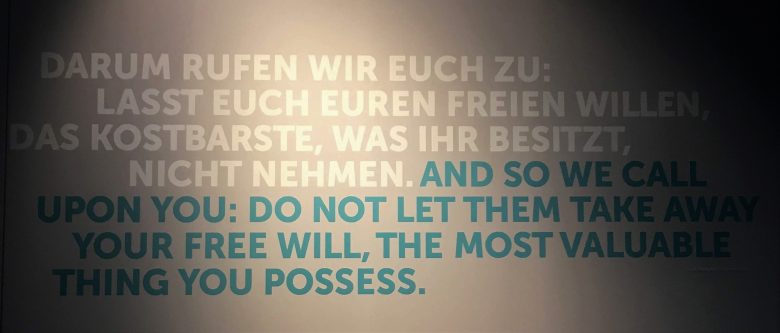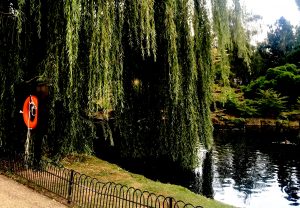“There is no wall that can withstand the power of ideas,” Axel Springer wrote in 1966. He had just built a 20-stories tall headquarters for his publishing company right beside the Berlin Wall in West Berlin, and he took out ads in newspapers to explain why. The building was a “symbol to the people of East Germany that freedom continued to exist.” Springer built in “confidence, rather than in defiance” and observed that “it is easier to be defiant than it is to be confident. Empty defiance,” he wrote, “merely serves to widen the gap between peoples. Confidence, on the other hand, is contagious.”
I read this on Monday in an upstairs room of the Wall Museum near Checkpoint Charlie in Berlin and almost cried. The museum was overwhelming when my friend and I entered, with photographs captioned in four languages filling every wall, and no air conditioning in a space that got warmer and warmer as we climbed the stairs. The exhibits were old and seemed to have been added to over time with little revision so each new milestone felt as if it had just happened.
The museum was founded in 1962 in a small apartment near the Wall, and 56 years later it sprawls and winds its way through multiple floors of a building that overlooks what was the third checkpoint (Charlie, after Alpha and Bravo) along the Berlin Wall. New technology and more space would probably help the museum get better Tripadvisor reviews and make it less overwhelming. Maybe the maze-like feeling of not knowing which way to turn would give way to something more orderly.
And yet. There is something hugely compelling about seeing what was written about the Berlin Wall contemporaneously instead of retrospectively. The best museums put us in the middle of history, offering insight but also understanding of what it was like, then. The 9/11 museum in New York, while modern and more curated, also overwhelms the visitor with choice of which plaque to read and which object to view. Being overwhelmed by all the stories from that terrible day seems right to me, and the Berlin Wall stood for decades. It has its own stories.
I can’t help but wonder if a refresh of the Wall Museum, five or ten years ago, might have seen Axel Springer’s editorial-like ad relegated to the archives, to be replaced by an interactive display. When I googled the piece I quoted at the beginning of this post, I got no hits. Springer’s words didn’t exist on the internet, at least not in a searchable way, until I wrote this post, but they are so very timely fifty-odd years later.
We say over and over again that those who don’t learn about history are doomed to repeat it. During my visit to the Wall Museum, I read about children taken from their families, some never to be reunited. There were stories of daring escapes, of government cruelty, and of the helpers who did what they could.
“In general, it is not the present that occupies me the most; in fact, it is the future. What we have today is a transition. I have not the slightest doubt about that. But what comes next is swathed in great darkness.” – Julius Leber, 1933*
The week before, I visited the Resistance Museum and learned about the brave people within Germany who tried in vain to take Hitler and his followers down from within, those who protected their vulnerable neighbors and stood up to power to say, This is not right. Many, if not most, of their stories ended with the date of their murder. The captions didn’t shy from that word – they weren’t sentenced to death or executed by the Nazi regime. They were murdered.
“Every German bears responsibility for Germany, no matter who he is or where he stands, in the homeland and abroad, in public and at home. No one can absolve him of this responsibility. He can transfer it to no one.” Herman Maas, 1933*
And in the end, the Resistance wasn’t enough.
“And so we call upon you: Do not let them take away your free will, the most valuable thing you possess.” – Resistance Museum, Berlin, Germany*
There were photographs in both museums, of brave men and women who risked their lives for their own freedom or the freedom of others. The Wall Museum has cars with clever hiding places, part of a hot air balloon, a glider, other pieces of paraphernalia given to them by those who escaped.
But it was people’s words that made me want to cry. Words have meaning, our stories have meaning, and ideas are more powerful than walls.
*Quotes from the wall of the Resistance Museum






Comments
Oh, Sarah, this is beautifully written! It really transports the anguish of the divide in Berlin – so close and yet so far away. I cannot be a fan of Axel Springer, but his juxtaposition of defiance and confidence is powerful and I’m happy to have learnt about it from you, it inspires me 🙂 Thank you for this post! 🙂